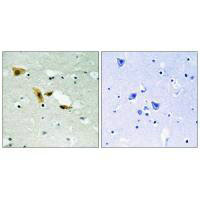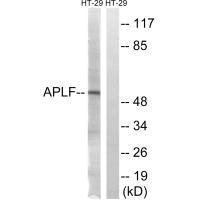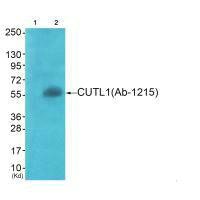APLF (Ab-116) Antibody
-
货号:CSB-PA109959
-
规格:¥2024
-
图片:
-
Immunohistochemistry analysis of paraffin-embedded human brain tissue using APLF (Ab-116) antibody.
-
Western blot analysis of extracts from HT-29 cells, using APLF (Ab-116) antibody.
-
Western blot analysis of extracts from COS7 cells (Lane 2), using APLF (Ab-116) antiobdy. The lane on the left is treated with systhesized peptide.
-
-
其他:
产品详情
-
产品名称:Rabbit anti-Homo sapiens (Human) APLF Polyclonal antibody
-
Uniprot No.:Q8IW19
-
基因名:APLF
-
宿主:Rabbit
-
反应种属:Human,Mouse
-
免疫原:Synthesized non-phosphopeptide derived from Human APLF around the phosphorylation site of serine 116 (R-N-S(p)-Q-V).
-
免疫原种属:Homo sapiens (Human)
-
克隆类型:Polyclonal
-
纯化方式:The antibody was affinity-purified from rabbit antiserum by affinity-chromatography using epitope-specific immunogen.
-
浓度:It differs from different batches. Please contact us to confirm it.
-
产品提供形式:Liquid
-
应用范围:ELISA,WB,IHC
-
推荐稀释比:
Application Recommended Dilution WB 1:500-1:3000 IHC 1:50-1:100 -
Protocols:
-
储存条件:Upon receipt, store at -20°C or -80°C. Avoid repeated freeze.
-
货期:Basically, we can dispatch the products out in 1-3 working days after receiving your orders. Delivery time maybe differs from different purchasing way or location, please kindly consult your local distributors for specific delivery time.
相关产品
靶点详情
-
功能:Nuclease involved in single-strand and double-strand DNA break repair. Recruited to sites of DNA damage through interaction with poly(ADP-ribose), a polymeric post-translational modification synthesized transiently at sites of chromosomal damage to accelerate DNA strand break repair reactions. Displays apurinic-apyrimidinic (AP) endonuclease and 3'-5' exonuclease activities in vitro. Also able to introduce nicks at hydroxyuracil and other types of pyrimidine base damage. Together with PARP3, promotes the retention of the LIG4-XRCC4 complex on chromatin and accelerate DNA ligation during non-homologous end-joining (NHEJ).
-
基因功能参考文献:
- characterization of the interaction of the APLF FHA domain with phosphorylated XRCC1 peptides PMID: 29059378
- These data suggest functional requirements for Ku and XRCC4 in APLF-dependent NHEJ and a unique role for Ku as a factor required to facilitate the nuclear retention of APLF. PMID: 23689425
- APLF promotes the assembly and activity of multi-protein Ku-DNA complexes containing all of the Non-homologous end joining (NHEJ) factors required for DNA ligation. PMID: 23178593
- Polynucleotide kinase and aprataxin-like forkhead-associated protein (PALF) acts as both a single-stranded DNA endonuclease and a single-stranded DNA 3' exonuclease and can participate in DNA end joining in a biochemical system. PMID: 21885877
- only a positive association (OR=1.58, 95% CI 1.05-2.46, P=0.027) was obtained for XRCC1 (Arg280His PMID: 21414327
- APLF has a role in chromosomal DNA double-strand break repair. PMID: 21211721
- The poly(ADP-ribose)-regulated protein APLF as a DNA-damage-specific histone chaperone. PMID: 21211722
- The s present solution structures of the two poly(ADP-ribose)-binding zinc finger modules of aprataxin and PNK-like factor (APLF), revealing a novel type of zinc finger. PMID: 20098424
- These data identify APLF as a novel component of the cellular response to DNA strand breaks in human cells. PMID: 17353262
- PALF is novel human AP endonuclease with conserved zinc-finger-like motifs involved in DNA strand break responses. PMID: 17396150
- APLF is an ATM target that is involved in nonhomologous end-joining and facilitates double-strand break repair, likely via interactions with Ku and XRCC4-DNA ligase IV. PMID: 18077224
- Study concludes that APLF can accumulate at sites of chromosomal damage via zinc finger-mediated binding to poly(ADP-ribose) and is a novel component of poly(ADP-ribose) signaling in mammalian cells. PMID: 18474613
显示更多
收起更多
-
亚细胞定位:Nucleus. Chromosome. Cytoplasm, cytosol.
-
蛋白家族:APLF family
-
数据库链接:
HGNC: 28724
OMIM: 611035
KEGG: hsa:200558
STRING: 9606.ENSP00000307004
UniGene: Hs.720369
Most popular with customers
-
-
YWHAB Recombinant Monoclonal Antibody
Applications: ELISA, WB, IF, FC
Species Reactivity: Human, Mouse, Rat
-
Phospho-YAP1 (S127) Recombinant Monoclonal Antibody
Applications: ELISA, WB, IHC
Species Reactivity: Human
-
-
-
-
-























